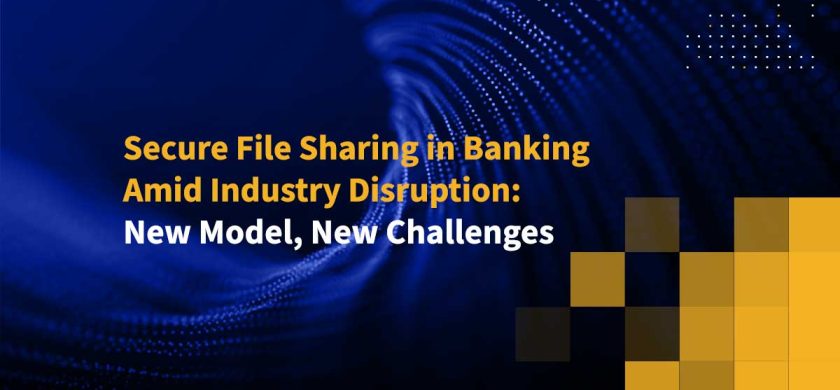
Secure File Sharing in Banking Amid Industry Disruption: New Model, New Challenges
Significant disruption in the banking industry is forcing traditional banks to rethink how they provide services to consumers. Inevitably, secure file sharing in banking must also be revisited.
Since the advent of mobile banking, branch traffic has declined significantly with no indication of the trend slowing down or reversing course. Times have changed, and branches need to change, too.
Most banks and credit unions cannot afford to abandon branches altogether. Proximity to a nearby branch is still a primary factor in choosing a retail bank. And even if consumers no longer visit branches to deposit checks or transfer funds, they still like the idea of being able to visit a branch to talk to a representative face-to-face to resolve problems, get advice or apply for products such as mortgages.
A New Model: Universal Banking
The drive for improving the branch experience has led many institutions to adopt a new model: universal banking. Under the new universal banking model, a bank employee is capable of handling all tasks in a bank—processing deposits and withdrawals, but also consulting with consumers about opening new accounts, optimizing finances, and resolving difficult problems.
Traditionally, tellers have worked behind a counter, while personal bankers worked at desks. By combining these roles, universal bankers roam the branch freely, greeting the customers at the door and then guiding them to a freestanding kiosk or table to access banking systems and access digital information.
Because universal bankers are mobile, they rely on mobile technology for access to consumer bank accounts, electronic forms, and digital sales and marketing collateral such as educational videos. As more documents containing personally identifiable information (PII) are more easily and frequently exchanged, secure file sharing in banking becomes more critical.
Secure file sharing in banking allows customers and third party organizations handling customer data to share sensitive content like loan applications, credit histories, pay stubs and other documents containing.
Secure File Sharing in Banking Under the New Universal Banking Model
Secure file sharing in banking is unattainable unless employees and customers can securely upload, download, share, and collaborate on sensitive information. In addition, bank employees and their customers must have mutual assurance that customer privacy is maintained and all PII is stored and exchanged within compliance. Critical security and governance capabilities must include:
- Full visibility and control over PII, including who has access to the content, whether it’s been modified, when it’s been shared and with whom
- Encryption of PII like social security numbers, credit scores, transaction records, etc., in transit and at rest
- “Secure containers” on mobile devices that shield valuable content from malware and unauthorized access
- Leak-proof editing on mobile devices so that users can edit but not save or duplicate content to new, unauthorized locations
- Support for two-factor authentication
- Support for remote wipe of PII on mobile devices that are lost or stolen
- Integration with Data Loss Prevention (DLP) solutions to avoid accidental distribution of sensitive content
Other important capabilities that enhance secure file sharing in banking include integration with the systems that hold customer and productivity enhancements that simplify how bankers share sensitive information with consumers. These include connectors to Microsoft SharePoint and Box and mobile integrations with Microsoft Office 365, respectively.
With the ability to quickly and easily access, share, and collaborate on content, universal bankers deliver the best possible service to prospective and existing customers. If universal bankers are able to access, share, and collaborate on content securely and in compliance with a multitude of regulations, then secure file sharing in banking has been achieved.
To learn how the Kiteworks secure file sharing and governance platform enables secure file sharing for banks and other financial institutions, schedule a custom demo of Kiteworks today.
Frequently Asked Questions
Secure file sharing is a way of transferring files between two or more computers, all while ensuring that the data remains secure and confidential. Encryption, data loss prevention (DLP), advanced threat protection (ATP), and multi-factor authentication (MFA) are just some of the security features used to enable secure file sharing.
Secure file sharing typically involves encrypting files during transit and ensuring they can only be accessed by users with the correct credentials, typically a username and password. Once downloaded, the files are also encrypted locally on the user’s device. This prevents unauthorized users from viewing them without the correct credentials. Some secure file sharing systems also provide an audit trail, so that administrators can track who has accessed each file.
Secure file sharing helps organizations keep their data safe and secure. By encrypting the data as it is transferred, secure file sharing prevents hackers and malicious actors from stealing or altering data. Additionally, secure file sharing can help organizations comply with data regulations and industry standards.
Regular file sharing is not encrypted, which means the data can be intercepted and read. Secure file sharing, on the other hand, uses encryption algorithms to scramble the data before it is sent, making it unreadable to anyone without the encryption key.
Yes, secure file sharing requires a secure connection. This means that the connection must use a secure protocol such as SFTP, FTPS, or HTTPS.
Additional Resources
- Blog PostWhat is the Best File Transfer Service?
- Blog PostSecure External File Sharing
- Blog PostNew Enterprise File Sharing Solution
- Blog PostBest Business File Sharing Software Solutions
- Blog PostWhat is Citrix ShareFile?